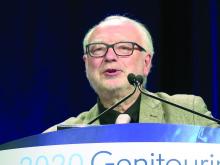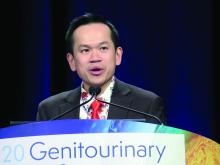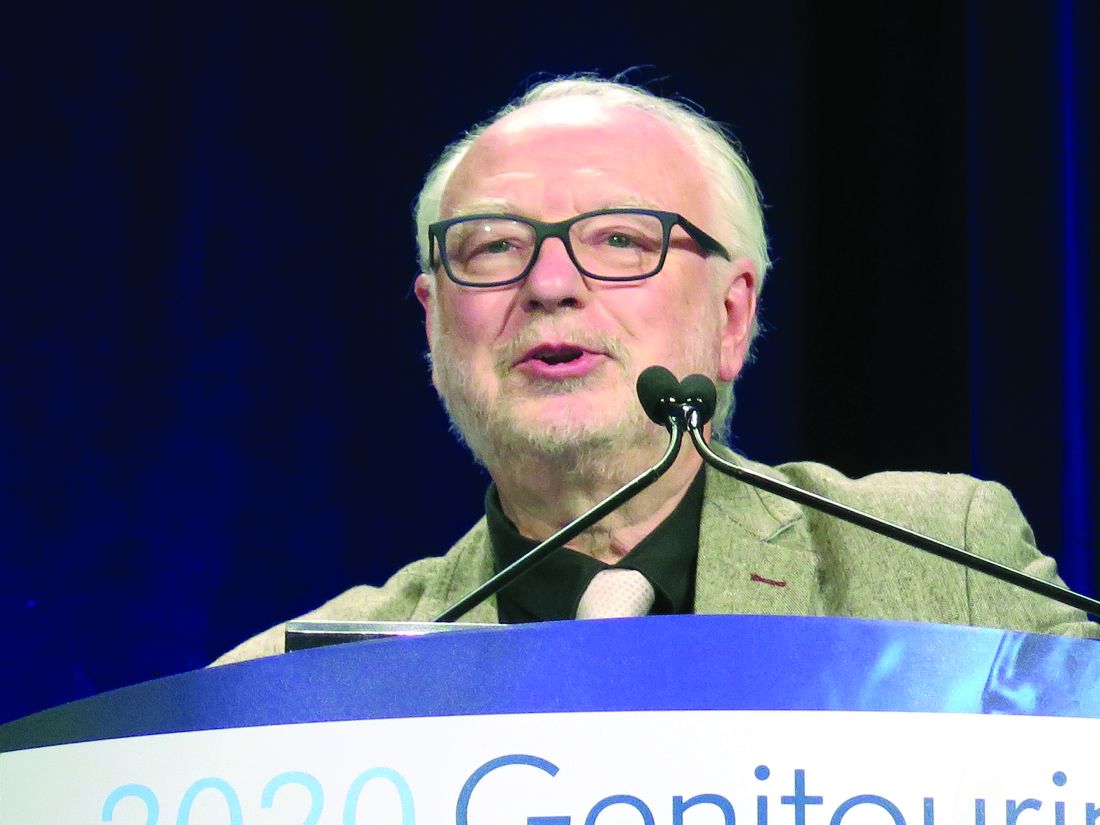User login
SAN FRANCISCO – an update of the CHHiP trial shows.
The 3,216 men in the phase 3 trial had node-negative T1b-T3a prostate cancer and were evenly assigned to a conventional regimen of 74 Gy delivered in 37 fractions, a hypofractionated regimen of 60 Gy in 20 fractions, or a hypofractionated regimen of 57 Gy in 19 fractions. All regimens were delivered with intensity-modulated techniques.
The trial’s 5-year results, previously reported, showed noninferiority of the 60-Gy regimen, compared with the 74-Gy regimen on risk of biochemical or clinical failure (hazard ratio, 0.84), prompting recommendation of the former as a new standard of care for localized prostate cancer (Lancet Oncol. 2016;17:1047-60). Noninferiority could not be established for the 57-Gy regimen.
The 8-year results were essentially the same, confirming noninferiority of the 60-Gy regimen (HR, 0.85) but not the 57-Gy regimen. Meanwhile, bowel and bladder toxicity continued to be low across regimens.
David P. Dearnaley, MB BCh, MD, of the Royal Marsden NHS Foundation Trust, London, reported the 8-year results at the 2020 Genitourinary Cancers Symposium, sponsored by the American Society for Clinical Oncology, ASTRO, and the Society of Urologic Oncology.
Study details
At a median follow-up of 9.3 years, the 8-year rate of freedom from biochemical failure (defined by Phoenix consensus guidelines) or clinical failure (cancer recurrence) was 80.6% with 74 Gy, 83.7% with 60 Gy, and 78.5% with 57 Gy, Dr. Dearnaley reported.
Analyses confirmed noninferiority of the 60-Gy regimen (HR, 0.85; 95% confidence interval, 0.72-1.01; P = .11), but not the 57-Gy regimen (HR, 1.17; 95% CI, 1.00-1.36; P = .10), as the upper bound of the confidence interval crossed the predefined 1.21 boundary for noninferiority.
In an unplanned analysis, the pattern among men younger than 75 years was similar to that in the entire trial population. But among men 75 years of age and older, the 57-Gy arm is actually outperforming the 74-Gy arm (HR, 0.77).
The three regimens yielded a similarly high rate of freedom from metastases, at about 95% in each arm. The 60-Gy regimen had an edge in overall survival relative to the 74-Gy regimen (88.6% vs. 85.9%; HR, 0.84) that is hard to explain, according to Dr. Dearnaley.
“Because there is an 8:1 ratio of non–prostate cancer deaths to prostate cancer deaths, you would have to postulate something other than prostate cancer being affected by the radiotherapy fractionation,” he said. “The answers on a postcard, because I can’t think of one.”
On central pathology review, nearly a fifth of evaluated trial patients had high-risk disease. “I know everybody wants to know about high-risk patients, but I’d rather take the trial results as a whole and look to see if there is any heterogeneity between those groups rather than perform a specific high-risk subgroup analysis,” Dr. Dearnaley said, expressing concern about performing too many subgroup analyses.
That said, older patients on the trial tended to have higher risk. “It does seem hypofractionation was particularly useful in those patients,” he noted. “Now, whether that’s anything to do with their pathology or whether it’s due to their age per se, I really don’t know.”
There were no differences between groups on rates of Radiation Therapy Oncology Group toxicity at 5 years, with grade 2 or worse bowel toxicity and bladder toxicity each seen in about 2% of patients.
There were no significant differences in rates of patient-reported “moderate or big” bowel bother (roughly 5%-8%) and urinary bother (roughly 7%-9%). For all regimens, bowel and urinary symptoms remained stable from 2-5 years.
Reassuring for practice
These updated findings “support the continued use of 60 Gy in 20 fractions as the standard of care,” Dr. Dearnaley said.
When the math is run to permit comparison, efficacy findings of the CHHiP trial show “amazing agreement” with those of the similar multinational PROFIT trial, he noted (J Clin Oncol. 2017 Jun 10;35(17):1884-90).
The absolute advantage in the failure-free rate of 3.1% and the overall survival rate of 2.7% for the 60-Gy regimen in CHHiP generated interest among symposium attendees about its possible superiority. “I think the 60 Gy is marginally more effective than the 74 Gy,” Dr. Dearnaley said, but he acknowledged that there are no statistics to prove that.
“This CHHiP update is fantastic,” said session cochair Paul L. Nguyen, MD, of the Dana-Farber Cancer Institute in Boston. “It is very reassuring that the initial results the investigators presented several years ago still hold up in the long term. It’s even more reassuring for the use of hypofractionation, and it’s great to know that we can use it across the age spectrum and it works well.”
This trial is the only noninferiority hypofractionation trial in prostate cancer that includes a sizable share of patients at high risk for poor outcomes, a population for whom efficacy of this strategy is of particular interest, Dr. Nguyen noted.
“That’s always been a question,” he said. “The majority of the data from the noninferiority trials is for the low- and intermediate-risk patients. So it really would be interesting to learn whatever we can about high-risk patients from this trial.”
The trial was funded by Cancer Research UK, Department of Health (UK), and the National Institute for Health Research Cancer Research Network. Dr. Dearnaley and Dr. Nguyen disclosed relationships with a range of pharmaceutical companies.
SOURCE: Dearnaley DP et al. GUCS 2020. Abstract 325.
SAN FRANCISCO – an update of the CHHiP trial shows.
The 3,216 men in the phase 3 trial had node-negative T1b-T3a prostate cancer and were evenly assigned to a conventional regimen of 74 Gy delivered in 37 fractions, a hypofractionated regimen of 60 Gy in 20 fractions, or a hypofractionated regimen of 57 Gy in 19 fractions. All regimens were delivered with intensity-modulated techniques.
The trial’s 5-year results, previously reported, showed noninferiority of the 60-Gy regimen, compared with the 74-Gy regimen on risk of biochemical or clinical failure (hazard ratio, 0.84), prompting recommendation of the former as a new standard of care for localized prostate cancer (Lancet Oncol. 2016;17:1047-60). Noninferiority could not be established for the 57-Gy regimen.
The 8-year results were essentially the same, confirming noninferiority of the 60-Gy regimen (HR, 0.85) but not the 57-Gy regimen. Meanwhile, bowel and bladder toxicity continued to be low across regimens.
David P. Dearnaley, MB BCh, MD, of the Royal Marsden NHS Foundation Trust, London, reported the 8-year results at the 2020 Genitourinary Cancers Symposium, sponsored by the American Society for Clinical Oncology, ASTRO, and the Society of Urologic Oncology.
Study details
At a median follow-up of 9.3 years, the 8-year rate of freedom from biochemical failure (defined by Phoenix consensus guidelines) or clinical failure (cancer recurrence) was 80.6% with 74 Gy, 83.7% with 60 Gy, and 78.5% with 57 Gy, Dr. Dearnaley reported.
Analyses confirmed noninferiority of the 60-Gy regimen (HR, 0.85; 95% confidence interval, 0.72-1.01; P = .11), but not the 57-Gy regimen (HR, 1.17; 95% CI, 1.00-1.36; P = .10), as the upper bound of the confidence interval crossed the predefined 1.21 boundary for noninferiority.
In an unplanned analysis, the pattern among men younger than 75 years was similar to that in the entire trial population. But among men 75 years of age and older, the 57-Gy arm is actually outperforming the 74-Gy arm (HR, 0.77).
The three regimens yielded a similarly high rate of freedom from metastases, at about 95% in each arm. The 60-Gy regimen had an edge in overall survival relative to the 74-Gy regimen (88.6% vs. 85.9%; HR, 0.84) that is hard to explain, according to Dr. Dearnaley.
“Because there is an 8:1 ratio of non–prostate cancer deaths to prostate cancer deaths, you would have to postulate something other than prostate cancer being affected by the radiotherapy fractionation,” he said. “The answers on a postcard, because I can’t think of one.”
On central pathology review, nearly a fifth of evaluated trial patients had high-risk disease. “I know everybody wants to know about high-risk patients, but I’d rather take the trial results as a whole and look to see if there is any heterogeneity between those groups rather than perform a specific high-risk subgroup analysis,” Dr. Dearnaley said, expressing concern about performing too many subgroup analyses.
That said, older patients on the trial tended to have higher risk. “It does seem hypofractionation was particularly useful in those patients,” he noted. “Now, whether that’s anything to do with their pathology or whether it’s due to their age per se, I really don’t know.”
There were no differences between groups on rates of Radiation Therapy Oncology Group toxicity at 5 years, with grade 2 or worse bowel toxicity and bladder toxicity each seen in about 2% of patients.
There were no significant differences in rates of patient-reported “moderate or big” bowel bother (roughly 5%-8%) and urinary bother (roughly 7%-9%). For all regimens, bowel and urinary symptoms remained stable from 2-5 years.
Reassuring for practice
These updated findings “support the continued use of 60 Gy in 20 fractions as the standard of care,” Dr. Dearnaley said.
When the math is run to permit comparison, efficacy findings of the CHHiP trial show “amazing agreement” with those of the similar multinational PROFIT trial, he noted (J Clin Oncol. 2017 Jun 10;35(17):1884-90).
The absolute advantage in the failure-free rate of 3.1% and the overall survival rate of 2.7% for the 60-Gy regimen in CHHiP generated interest among symposium attendees about its possible superiority. “I think the 60 Gy is marginally more effective than the 74 Gy,” Dr. Dearnaley said, but he acknowledged that there are no statistics to prove that.
“This CHHiP update is fantastic,” said session cochair Paul L. Nguyen, MD, of the Dana-Farber Cancer Institute in Boston. “It is very reassuring that the initial results the investigators presented several years ago still hold up in the long term. It’s even more reassuring for the use of hypofractionation, and it’s great to know that we can use it across the age spectrum and it works well.”
This trial is the only noninferiority hypofractionation trial in prostate cancer that includes a sizable share of patients at high risk for poor outcomes, a population for whom efficacy of this strategy is of particular interest, Dr. Nguyen noted.
“That’s always been a question,” he said. “The majority of the data from the noninferiority trials is for the low- and intermediate-risk patients. So it really would be interesting to learn whatever we can about high-risk patients from this trial.”
The trial was funded by Cancer Research UK, Department of Health (UK), and the National Institute for Health Research Cancer Research Network. Dr. Dearnaley and Dr. Nguyen disclosed relationships with a range of pharmaceutical companies.
SOURCE: Dearnaley DP et al. GUCS 2020. Abstract 325.
SAN FRANCISCO – an update of the CHHiP trial shows.
The 3,216 men in the phase 3 trial had node-negative T1b-T3a prostate cancer and were evenly assigned to a conventional regimen of 74 Gy delivered in 37 fractions, a hypofractionated regimen of 60 Gy in 20 fractions, or a hypofractionated regimen of 57 Gy in 19 fractions. All regimens were delivered with intensity-modulated techniques.
The trial’s 5-year results, previously reported, showed noninferiority of the 60-Gy regimen, compared with the 74-Gy regimen on risk of biochemical or clinical failure (hazard ratio, 0.84), prompting recommendation of the former as a new standard of care for localized prostate cancer (Lancet Oncol. 2016;17:1047-60). Noninferiority could not be established for the 57-Gy regimen.
The 8-year results were essentially the same, confirming noninferiority of the 60-Gy regimen (HR, 0.85) but not the 57-Gy regimen. Meanwhile, bowel and bladder toxicity continued to be low across regimens.
David P. Dearnaley, MB BCh, MD, of the Royal Marsden NHS Foundation Trust, London, reported the 8-year results at the 2020 Genitourinary Cancers Symposium, sponsored by the American Society for Clinical Oncology, ASTRO, and the Society of Urologic Oncology.
Study details
At a median follow-up of 9.3 years, the 8-year rate of freedom from biochemical failure (defined by Phoenix consensus guidelines) or clinical failure (cancer recurrence) was 80.6% with 74 Gy, 83.7% with 60 Gy, and 78.5% with 57 Gy, Dr. Dearnaley reported.
Analyses confirmed noninferiority of the 60-Gy regimen (HR, 0.85; 95% confidence interval, 0.72-1.01; P = .11), but not the 57-Gy regimen (HR, 1.17; 95% CI, 1.00-1.36; P = .10), as the upper bound of the confidence interval crossed the predefined 1.21 boundary for noninferiority.
In an unplanned analysis, the pattern among men younger than 75 years was similar to that in the entire trial population. But among men 75 years of age and older, the 57-Gy arm is actually outperforming the 74-Gy arm (HR, 0.77).
The three regimens yielded a similarly high rate of freedom from metastases, at about 95% in each arm. The 60-Gy regimen had an edge in overall survival relative to the 74-Gy regimen (88.6% vs. 85.9%; HR, 0.84) that is hard to explain, according to Dr. Dearnaley.
“Because there is an 8:1 ratio of non–prostate cancer deaths to prostate cancer deaths, you would have to postulate something other than prostate cancer being affected by the radiotherapy fractionation,” he said. “The answers on a postcard, because I can’t think of one.”
On central pathology review, nearly a fifth of evaluated trial patients had high-risk disease. “I know everybody wants to know about high-risk patients, but I’d rather take the trial results as a whole and look to see if there is any heterogeneity between those groups rather than perform a specific high-risk subgroup analysis,” Dr. Dearnaley said, expressing concern about performing too many subgroup analyses.
That said, older patients on the trial tended to have higher risk. “It does seem hypofractionation was particularly useful in those patients,” he noted. “Now, whether that’s anything to do with their pathology or whether it’s due to their age per se, I really don’t know.”
There were no differences between groups on rates of Radiation Therapy Oncology Group toxicity at 5 years, with grade 2 or worse bowel toxicity and bladder toxicity each seen in about 2% of patients.
There were no significant differences in rates of patient-reported “moderate or big” bowel bother (roughly 5%-8%) and urinary bother (roughly 7%-9%). For all regimens, bowel and urinary symptoms remained stable from 2-5 years.
Reassuring for practice
These updated findings “support the continued use of 60 Gy in 20 fractions as the standard of care,” Dr. Dearnaley said.
When the math is run to permit comparison, efficacy findings of the CHHiP trial show “amazing agreement” with those of the similar multinational PROFIT trial, he noted (J Clin Oncol. 2017 Jun 10;35(17):1884-90).
The absolute advantage in the failure-free rate of 3.1% and the overall survival rate of 2.7% for the 60-Gy regimen in CHHiP generated interest among symposium attendees about its possible superiority. “I think the 60 Gy is marginally more effective than the 74 Gy,” Dr. Dearnaley said, but he acknowledged that there are no statistics to prove that.
“This CHHiP update is fantastic,” said session cochair Paul L. Nguyen, MD, of the Dana-Farber Cancer Institute in Boston. “It is very reassuring that the initial results the investigators presented several years ago still hold up in the long term. It’s even more reassuring for the use of hypofractionation, and it’s great to know that we can use it across the age spectrum and it works well.”
This trial is the only noninferiority hypofractionation trial in prostate cancer that includes a sizable share of patients at high risk for poor outcomes, a population for whom efficacy of this strategy is of particular interest, Dr. Nguyen noted.
“That’s always been a question,” he said. “The majority of the data from the noninferiority trials is for the low- and intermediate-risk patients. So it really would be interesting to learn whatever we can about high-risk patients from this trial.”
The trial was funded by Cancer Research UK, Department of Health (UK), and the National Institute for Health Research Cancer Research Network. Dr. Dearnaley and Dr. Nguyen disclosed relationships with a range of pharmaceutical companies.
SOURCE: Dearnaley DP et al. GUCS 2020. Abstract 325.
REPORTING FROM GUCS 2020


